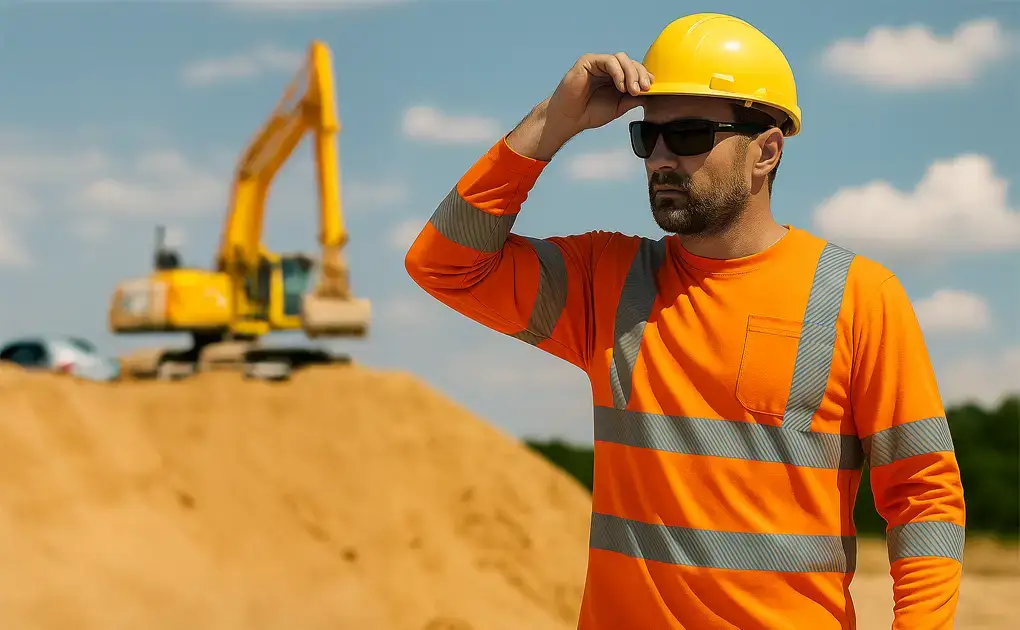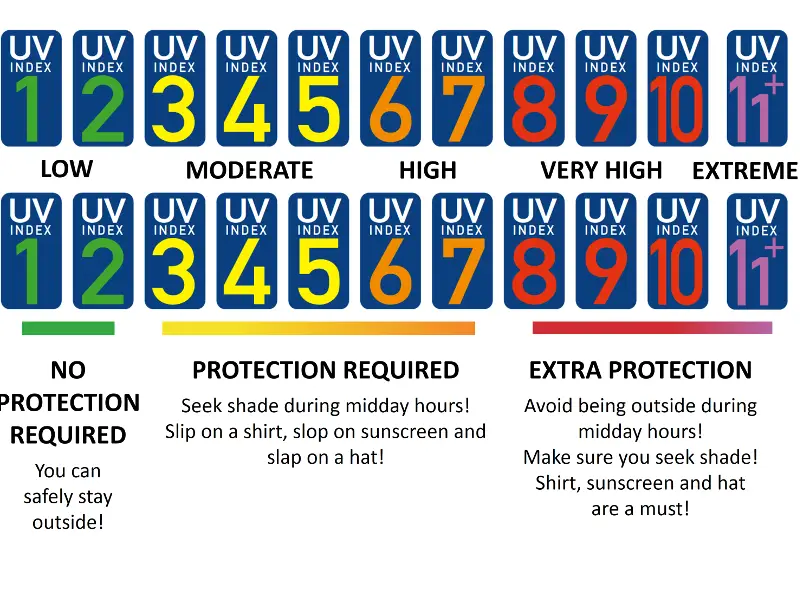
UV protection in the workplace
In many industries, working outdoors is part of everyday life. What appears harmless at first glance can have serious long-term health consequences. This is why protection against UV radiation is becoming increasingly important for companies when it comes to the health and safety of their employees.
What makes UV radiation in the workplace so dangerous?
The effects of UV radiation do not always have to be immediately apparent like sunburn. A distinction can be made between acute and chronic damage.
Acute damage
- Sunburn
- corneal and conjunctivitis
- heat damage
Chronic damage
- premature skin ageing
- skin cancer
- grey cataracts
UV radiation is one of the most significant health risks, especially during outdoor activities, as it constantly affects the skin, even on cloudy days. The high-visibility long-sleeved shirt PTW-SHIRT-L and the high-visibility long-sleeved polo shirt PTW-POLO-L can be used to counteract this.
Thanks to the fluorescent cotton-polyester blend and certified UPF 50+ (EN 13758-2), these combine maximum UV protection with high wearing comfort and excellent visibility - perfect for working in strong sunlight.
Sun protection is mandatory – what employers must observe
Employers are legally obliged to effectively protect their employees from UV radiation when working outdoors. This is based on the EU Occupational Health and Safety Directive (EEC).
Central employer obligations (according to EEC):
- Identification and assessment of all work-related health risks, including natural UV radiation (Art. 6 and Art. 9)
- Determination and implementation of suitable protective measures according to the TOP principle (technical, organisational, personal) to minimise UV exposure (Art. 6 para. 2)
- Provision of suitable personal protective equipment (PPE), e.g. UV protective clothing, if other measures are not sufficient (Art. 9 para. 1 lit. b/c)
- Instruction and training of employees on existing UV risks and necessary protective measures (Art. 10)
White skin cancer
In year 2023, 443 out of every 100,000 people in Germany were diagnosed with skin cancer. Around 386 of these were white skin cancer cases, which corresponds to 87% of all cases. Since 2015, white skin cancer has been officially recognised as an occupational disease (BK 5103). In particular in the construction and gardening industry, it is the most frequently recognised occupational disease.
The UV index as an early indicator

The UV index (UVI) is an international measurement of the UV radiation that causes sunburn. The higher the value, the faster the risk of UV damage to the skin and eyes. The UVI is recalculated daily and takes into account factors such as:
- position of the sun
- cloud cover
- ozone layer
- geographical location
We recommend that you enquire about the current UV radiation values, as measured by the UV index, from the country-specific weather services. Actively use this information for your risk assessment and daily planning.
Weather services:
- France: Météo-France
- Poland: Instytut Meteorologii i Gospodarki Wodnej (IMGW)
- United Kingdom: Met Office
- Portugal: Instituto Português do Mar e da Atmosfera (IPMA)
- Spain: Agencia Estatal de Meteorología (AEMET)
- Romania: Administrația Națională de Meteorologie (ANM)
- Netherlands: Koninklijk Nederlands Meteorologisch Instituut (KNMI)
Measures depending on the UV index
Protective measures are considered necessary from a UV index of 3:
- Technical sun protection (e.g. canopies)
- Shifting working hours (e.g. to the morning hours) into the morning hours)
- UV protective clothing (certified UPF 50+)
- Sunscreen (SPF 50+)
- Headgear with neck protection
- Training on UV prevention
UV protective clothing as an effective PPE solution
While technical and organisational measures are important, personal protective equipment (PPE) remains the central pillar of UV protection. UV protective clothing offers durable and reliable protection, regardless of application, weather conditions or forgotten precautionary measures, such as:
- Durable protection when used correctly
- Certified UV protection factor (UPF 50+) in accordance with EN 13758-2
- Easy integration into existing PPE concepts
Advantages of certified UV protective clothing
By taking consistent UV protection measures, companies can:
- Reduce absenteeism
- Prevent occupational illnesses
- Avoid rehabilitation and compensation benefits
- Increase employer attractiveness
The mix of measures according to the TOP principle:
If you are not sure how to approach adequate measures, then perhaps the TOP principle will help you. It provides a ranking of occupational health and safety measures that serve to avoid or minimise hazards.
| Measure | Examples |
| Technical | Sun sails, Canopies |
| Organisational | Shifting working hours, breaks in the shade |
| Personal | UV protective clothing, headgear, sunscreen, training |
(Only in Germany) Funding for PTW-SHIRT-L and PTW-POLO-L
Many UV protection measures are supported in Germany by the trade association "BG Bau".
Among other things, long-sleeved high-visibility shirts with a UV protection factor of at least 30 that are certified in accordance with EN ISO 20471:2013 in class 2 or 3 are eligible for funding. The employers' liability insurance association for the construction industry will cover up to 50% of the purchase costs, up to a maximum of €30 per item of clothing.
For more information, please visit: https://www.bgbau.de/service/angebote/arbeitsschutzpraemien/praemie/individueller-sonnen-und-hitzeschutz
Conclusion for B2B companies: UV protective clothing is future-proof
For companies with employees working outdoors, certified UV protective clothing is no longer a ‘nice-to-have’, but a strategic investment:
- work safety
- health protection
- legal compliance
- economy
- employer attractiveness
FAQ: UV protective clothing and UV protection in the workplace
1. Why is UV protection in the workplace so important?
UV radiation can cause both acute damage (e.g. sunburn, heat damage) and long-term illnesses (skin cancer, cataracts).
2. Who is particularly at risk
Professions with regular outdoor activities, such as gardeners and landscapers, construction workers, road builders, roofers, farmers and foresters, scaffolders, and post and parcel carriers.
3. Who must provide UV protective clothing?
Employers in Germany are obliged under the to provide suitable personal protective equipment (PPE) free of charge if UV radiation in the workplace cannot be reduced by other measures.
4. Is UV radiation already considered an occupational disease?
If employees are exposed to intense sunlight outdoors for many years, white skin cancer can only be recognised as an occupational disease (BK 5103) in Germany. The diagnosis is made by a specialist and the statutory accident insurance decides whether to recognise it.
5. What does UV protection factor mean for clothing?
The UV protection factor (UPF) indicates how strongly a textile blocks UV radiation. Clothing in accordance with EN 13758-2 provides reliable protection by filtering out the majority of harmful rays - similar to sun cream, but permanently integrated into the fabric.
6. What is the difference between UV protective clothing and normal high-visibility clothing?
High-visibility clothing primarily ensures visibility in low light conditions. Special UV protective clothing also actively protects the skin from harmful UV radiation. Ideally, both protective functions are combined, as with the PREVENT® long-sleeved shirts from ASATEX.
7. Is UV protective clothing subsidised?
There are currently no EU-wide subsidy programmes. Please find out about possible funding programmes in your country.
8. How do I care for UV protective clothing correctly?
Pay attention to the manufacturer's care instructions. Many UV protective fabrics retain their effect even after frequent washing if they are cleaned gently. Washing them too hot or using aggressive chemicals can impair the protection.
9. Does the UV protection remain effective even after many washes?
High-quality UV protective clothing remains effective even after many washes, as the protection is usually firmly anchored in the fabric. Regular visual inspections help to detect wear at an early stage.
